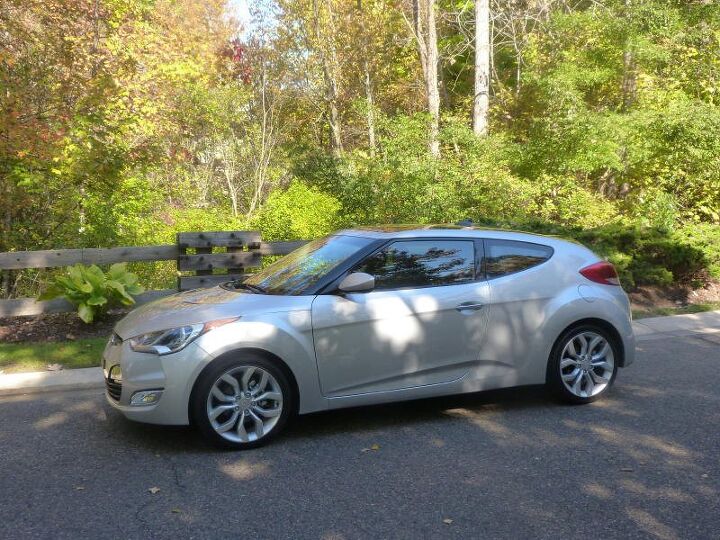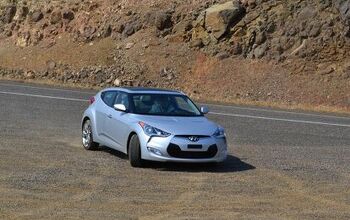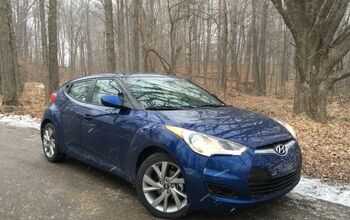Review: Hyundai Veloster Take Two
The author’s expectations play a large but rarely disclosed role in any auto review. Expect a car to be awful, and it turns out to be adequate? Then the review might even seem positive. On the other hand, if reviewers buy into the hype surrounding an upcoming model, and it turns out to be only pretty good, then the reviews can turn ugly. No one wants to be sold a bill of goods. I approached the Hyundai Veloster with different expectations than most of the automotive press.
Why? I never bought the hype gushing forth from Hyundai. I knew the Veloster would have the same 138-horsepower direct-injected 1.6-liter engine as the new Accent, but saddled with more curb weight (2,430-2,588 vs. 2,584-2,740 pounds). I also knew that Hyundai had yet to master the art of suspension tuning. (I’m also not buying the hype surrounding the Cadillac ATS and Scion FR-S until I have a chance to drive them.)
We already knew what the Veloster would look like. It’s a distinctive shape, made even more so by having two doors on the passenger side (the rear one “hidden”) but only one on the driver side. (I personally prefer the side with the rear door. You?) Fully loaded cars get the most attractive wheels complete with color-keyed inserts. On public streets the Veloster looks even wilder than it did at the auto shows, especially from the rear. People on the street recognized something new, and asked about the Veloster more than any other press car I’ve had. If Hyundai’s hype hadn’t persuaded journalists to expect an outstanding driving experience, this exotic shape would have.
The interior I wished for in the Accent? It’s here in the Veloster, complete with Cayennesque grab handles (that actually feel more solid here than in the Porsche), sportier upholstery, and available red/black color scheme. The designers were permitted to get a little more crazy in the sport coupe, but not to the detriment of ergonomics or good taste. The instruments are conventionally located and arranged while the center stack controls are easy to reach and operate. A seven-inch display and A/V inputs are standard, while a household-type power outlet is part of the Tech Package. Hyundai execs have personally tested the possibility of playing an Xbox in the car (while stationary). Hyundai’s new Blue Link adds some apps (like Pandora) along with OnStar-like emergency services, with an OnStar-like monthly fee after the first few months. There are also a couple of fuel economy-related games you can play, at least one of which compares the efficiency of your driving style to those of other Veloster owners.
The Veloster’s driver seat is better bolstered and more substantial than that in the Accent, if still not to the degree I’d prefer, but is similarly lacking in lumbar support. There’s only a single manual height adjustment, so the tilt of the cushion cannot be separately adjusted. But at least the steering wheel telescopes as well as tilts, unlike in the Accent. The view forward is open—you don’t sit too low in the car—the view rearward not so much thanks to a narrow, bifurcated rear window and stylishly raked C-pillars. The Tech Package with its rearview camera and rear parking sensors can come in handy. There’s enough room for heads and legs in the rear seat (adults up to 5-9 or so fit without issue) to make me wonder about the absence of a left rear door. Past three-door vehicles all ended up growing a fourth, and I would not be surprised to see history repeat itself with a future Veloster redesign. Also enough cabin width for three across in a pinch if Hyundai hadn’t designed the seat with an integral center console. Cargo volume is on the tight side, but sufficient for even sizable grocery runs.
Hyundai execs are apologetic about the Veloster’s performance, admitting that while the original concept was “eco-sport” the end result is more eco and less sport. Personally, I don’t mind limited power if the engine revs smoothly and eagerly, and the new Hyundai 1.6 does. I banged the rev limiter once because, eyes on the road, I wasn’t aware I was approaching it. As in the Accent, if anything I’d appreciate more of the good sort of noise at high rpm. Those looking for a punch in the lower back will be disappointed, though, as there’s little torque in play. Hyundai won’t confirm that a turbocharged variant is on the way to rectify this shortcoming, but one almost certainly is.
Okay, let me qualify that lack of disappointment. I was pleasantly surprised by the Veloster’s manual transmission, as its shift feel and ratios are much better than those in the Accent (though first and second remain too far apart while fifth and sixth remain too close together).
Accent6MTVeloster6MTVelosterDCT1st3.773.623.622nd2.051.961.963rd1.291.371.304th1.041.040.945th0.890.790.726th0.770.690.57FD3.644.274.81Simply put, the Veloster’s shifter and manual transmission should be in the Accent. Why Hyundai had two groups of engineers where one would have done a better job escapes me.
The ratios of the automated dual-clutch transmission, Hyundai’s first and developed in-house, are better yet. But on the road the theoretical advantages of a dual-clutch transmission fail to materialize. Shifts, though admirably smooth despite the employment of the cheaper-to-maintain dry clutches that have been such a drivability headache for Ford, are not lightning quick like those of VW’s dual-wet-clutch DSG transmission. I sense a tradeoff. Worse, acceleration feels considerably more sluggish with the DCT, even though it has a shorter final drive ratio. With no torque converter to sap the engine’s power, why might this be? City fuel economy is a bit better with the DCT (EPA city 29 MPG vs. 28), while the manual wins on the highway (40 vs. 38).
Perhaps the sluggishness of the DCT powertrain shaped my entire perception of the car. I can find no other convincing explanation for why the manual transmission Veloster felt lighter and more agile than its DCT counterpart. Okay, is it lighter, but only by 73 pounds. The Tech Package on the DCT car adds a few more, some of them possibly in its unique color-keyed wheels. Enough to make a difference? Whatever the reason, the manual transmission car felt balanced, poised, planted, and almost (but not quite) agile while the DCT car felt heavier and less willing to change directions. Unfortunately, even the manual car doesn’t feel significantly more agile than its considerably heftier arch-rival, the 3,060-pound Scion tC. Neither comes across as “tossable.” Lighter yet more communicative steering would help I the Hyundai’s case.
On the flip side, the Veloster also feels more solid than its kinship with the Accent and curb weight might suggest. Though bumps occasionally elicit sharp reactions, ride quality and noise levels are generally very livable. I’d much rather commute in the Veloster than in the bouncier Elantra sedan that provided the basis for the sport coupe’s twist-beam rear suspension.
So how much will this sporty looking, not so sporty driving Hyundai set you back? If you can live with 17-inch wheels, a steel roof, and a 196-watt, six-speaker audio system, then $18,060. The Style Package (18s, panoramic sunroof, fog lights, leather steering wheel, leatherette seat bolsters, 450-watt audio) adds $2,000. The Tech Package (color-keyed wheels, nav with rearview camera and sensors, proximity key, 115v outlet) adds another $2,000.
Compared to the Veloster with Style Package, a Scion tC checks in $755 lower, but based on TrueDelta’s car price comparison tool also includes about $600 less content. So the two end up very close in price. Which to get? The Hyundai looks more distinctive and is simply sexier, while the tC packs fifty-percent more displacement under its hood and has a roomier rear seat (but no third door to aid access to it). I enjoyed driving the tC more, but this is relative. In both cars’ defense, if you want to have considerably more fun, you’re going to have to spend considerably more money. Even a Ford Focus SE or Mazda3 is nearly $2,000 more when similarly equipped. In the other direction, an Accent SE costs about $1,500 less. For those who care about such things, the Veloster’s more stylish exterior and upgraded interior will easily be worth this premium.
So, the Veloster isn’t as fun as it looks. But its performance and handling are adequate, while its styling, feature set and price are very attractive. As-is, it will fit the bill for many sporty coupe buyers. Those who insist on go with their show needn’t despair, only patiently wait for the turbo Hyundai’s not yet talking about.
Hyundai provided the vehicle, insurance and fuel for this review during a media drive event.
Michael Karesh operates TrueDelta, an online source of automotive pricing and reliability data.
Michael Karesh lives in West Bloomfield, Michigan, with his wife and three children. In 2003 he received a Ph.D. from the University of Chicago. While in Chicago he worked at the National Opinion Research Center, a leader in the field of survey research. For his doctoral thesis, he spent a year-and-a-half inside an automaker studying how and how well it understood consumers when developing new products. While pursuing the degree he taught consumer behavior and product development at Oakland University. Since 1999, he has contributed auto reviews to Epinions, where he is currently one of two people in charge of the autos section. Since earning the degree he has continued to care for his children (school, gymnastics, tae-kwan-do...) and write reviews for Epinions and, more recently, The Truth About Cars while developing TrueDelta, a vehicle reliability and price comparison site.
More by Michael Karesh
Latest Car Reviews
Read moreLatest Product Reviews
Read moreRecent Comments
- Ras815 "Showroom quality"? Which showroom would that be - a rural small-town used car lot?
- TheMrFreeze Whenever I see "Junior" used like this, in my mind I hear Sean Connery calling Harrison Ford "Junior" in "Indiana Jones and the Last Crusade"
- Buickman Buick out of Flint, Caddy to NY & Back, now this...gives 'em something to do in order to justify their existence while covering for incompetence & ineptitude.what's that about musical chairs on the Titanic?for those not aware, GM already sold the land under The Tubes.finance & legal types secluded in style while Musk gets to work making RoboCops to protect them from the masses.UnBarrable
- Analoggrotto TTAC never misses a chance to give Hyundai Kia maximum exposure. Hey, can't say I blame ya, gotta pay for that GT3RS somehow.
- Bpscarguy Maryland!!!!!




















































Comments
Join the conversation
Please proofread your post before making public. The amount of spelling and grammatical errors in this review actually hinders the ability to read and understand what you're trying to say.
Everybody seems to have good reviews of their cars so far, (veloster owners) and while I am impressed with the improvement in quality of Hyundai/Kia products, I still have to say/ask -- it's still new, and it rides and drives good NOW -- but will it still be on the road in 10 years? Or 17 years? My 1995 Honda Prelude Si is still running strong, looks as good as the day it rolled off the line in Japan, and is still on the same engine, no oil leaks or seeping rings -- compression only a few pounds off in each cylinder from the original spces ...and it has over 300K on the odometer. I have a feeling you won't find any Velosters that can hold credit the same in almost 20 years from today. Hope I'm wrong -- but I doubt it.